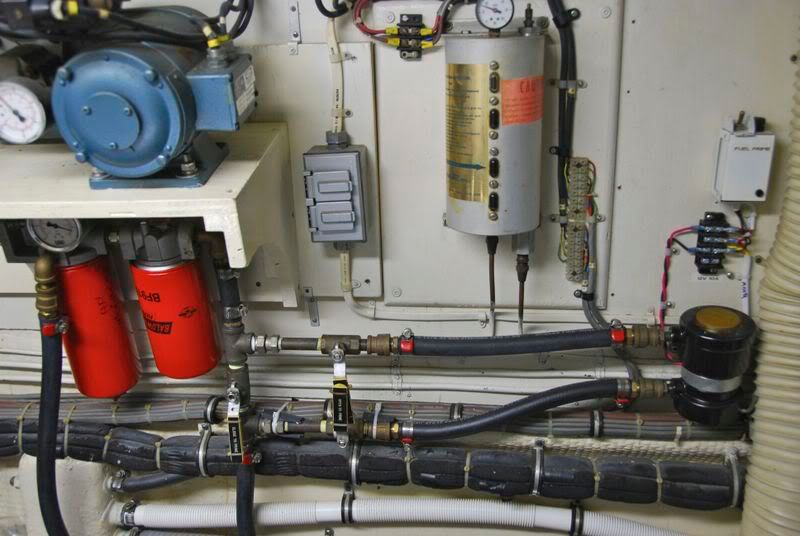rangerscott275
Well-known member
- Joined
- Nov 13, 2005
- Messages
- 241
- Hatteras Model
- 53' MOTOR YACHT (1969 - 1988)
Hello,
I recently added a fleetguard filter to my existing fuel filtration system. I have VT8-370s so my set up is prob different than most. Originally I had twin racor 1000's set up which then fed into a big blue canister on the side of my engine. Inside the canister was a drop in type filter....I assume this was OE. A combination of reasons made me want to get rid of this big blue sucker....namely air leaks, difficulty servicing and filter replacement issues. So, in it's place I installed the fleetguard filter head package and an FF 104 fuel filter.
Now my fuel runs into racor, then from there through a check valve and then into the fleetguard, then into the engine itself. I was working with the cummins dealer to get this setup worked out. A couple of notes....first, the cummins dealer actually charged me hourage for his time researching what parts I'd need....unbelievable at $110 an hour....Second, I am looking at my bill now more closely....and I was charged $86.29 per checkvalve!! Is this normal? It is a freaking elbow with threads on it and a ball in it... In the future, is there a better way to order this type of part?? Finally, I can't seem to get through to the cummins guys who I had been working with to ask him this...but....he sold me two FF 104 filters for this new filter head. I can't seem to find what Micron they are online (the stuff came in mail so I didn't speak to him directly since receiving), nor can I find out if they will be able to adequately handle the flow required for my engines. They are pretty small filters...like just over 4 inches tall. My Racors have water seperator on them so I know I don't need that in this filter as much (since it is secondary), but is this the right filter for the job? I notice in the pics posted by others that when installing the 'Tony' from seaboard system that everyone loves, they use a combo of the FF 5103 and the FS 1000. Is my setup using the racor and the FF 104 achieving same thing?
Thanks!
I recently added a fleetguard filter to my existing fuel filtration system. I have VT8-370s so my set up is prob different than most. Originally I had twin racor 1000's set up which then fed into a big blue canister on the side of my engine. Inside the canister was a drop in type filter....I assume this was OE. A combination of reasons made me want to get rid of this big blue sucker....namely air leaks, difficulty servicing and filter replacement issues. So, in it's place I installed the fleetguard filter head package and an FF 104 fuel filter.
Now my fuel runs into racor, then from there through a check valve and then into the fleetguard, then into the engine itself. I was working with the cummins dealer to get this setup worked out. A couple of notes....first, the cummins dealer actually charged me hourage for his time researching what parts I'd need....unbelievable at $110 an hour....Second, I am looking at my bill now more closely....and I was charged $86.29 per checkvalve!! Is this normal? It is a freaking elbow with threads on it and a ball in it... In the future, is there a better way to order this type of part?? Finally, I can't seem to get through to the cummins guys who I had been working with to ask him this...but....he sold me two FF 104 filters for this new filter head. I can't seem to find what Micron they are online (the stuff came in mail so I didn't speak to him directly since receiving), nor can I find out if they will be able to adequately handle the flow required for my engines. They are pretty small filters...like just over 4 inches tall. My Racors have water seperator on them so I know I don't need that in this filter as much (since it is secondary), but is this the right filter for the job? I notice in the pics posted by others that when installing the 'Tony' from seaboard system that everyone loves, they use a combo of the FF 5103 and the FS 1000. Is my setup using the racor and the FF 104 achieving same thing?
Thanks!


